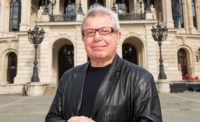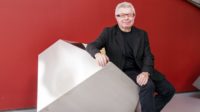| Photo courtesy Christine McMonagle/The Jewish Museum |
“Daniel Libeskind’s Line of Fire” runs through January 30, 2011, at The Jewish Museum in New York. Libeskind designed the exhibition using 40 menorahs from the museum’s collection. Click on the slide show button to see images. |
Daniel Libeskind’s building signature is often characterized by a lightning-bolt scrawl, clearly visible in his designs for The Contemporary Jewish Museum in San Francisco, the Jewish Museum in Berlin, and even “Villa Libeskind,” the prefab housing line he launched in 2010.
The latest rendition of the architect’s signature can be found in a small gallery in The Jewish Museum in New York, but it barely flickers.
The installation “A Hanukkah Project: Daniel Libeskind’s Line of Fire,” which opened November 19 and runs through January 30, 2011, features 40 menorahs from the museum’s collection. The menorahs, which range in age and provenance, sit on a jagged, red-painted wood table. Quotations about the spiritual nature of fire from a wide range of luminaries – Emily Dickinson, Yannai, and Jacques Derrida among them – are printed on the room’s blue walls, providing background and context for the undulating line of Hanukkah lamps of varying heights and shapes.
Every other year, the museum invites a contemporary artist to create a Hanukkah-themed installation. Susan L. Braunstein, curator of archaeology and Judaica, invited Libeskind to participate after working with him on a jury for the museum’s exhibition “Reinventing Ritual,” which closed earlier this year. “His style is so bold and innovative,” she said, and “he’s incredibly sensitive to memory.”
While Libeskind said yes the day after the museum asked him to create the installation, his busy schedule meant that he mostly collaborated from afar. Braunstein chose the menorahs (she spent seven years cataloguing all 1,002 in the collection). “They were some of my favorites,” she said of those in the exhibition, including Richard Meier’s tin-coated copper lamp (1985), each branch an iconic building motif in miniature; a spare, tomb-shaped limestone lamp from possibly late 19th-century Palestine; and Karim Rashid’s 2004 neon green silicone lamp, resembling a drop of spilled milk, mid-splash.
With Braunstein as his aide-de-camp, Libeskind chose the quotes, the paint colors, the typeface for all text, and of course, designed the table. “We had this great rhythm going. He was very particular,” said Braunstein.














































Post a comment to this article
Report Abusive Comment